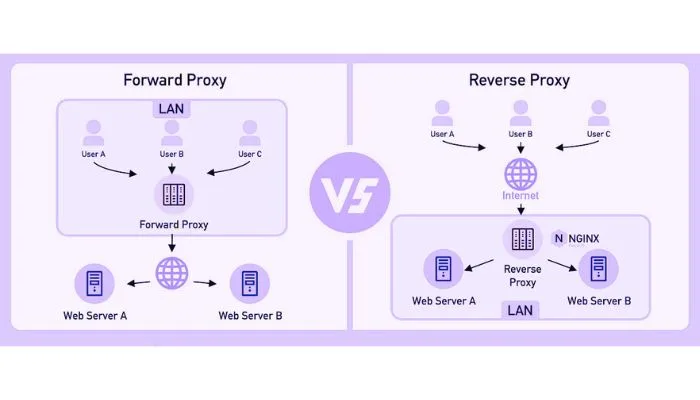Table of Contents
What is Reverse Proxy?
Reverse proxies are a special kind of proxy server. While a regular proxy server safeguards end users, a reverse proxy does the opposite. A reverse proxy is a server that takes requests from clients, sends them to another server (or servers) to be processed, and then returns the results to the originating client as though the proxy server had done the processing. The client has no idea that another server is processing its request; all of its interactions take place with the reverse proxy server.
A reverse proxy is a server that sits between client devices and web servers, acting as an intermediary for requests from clients seeking resources from the servers. Unlike a traditional forward proxy, which handles requests from clients to external servers, a reverse proxy handles requests from clients to internal servers.
What is a proxy server?
A proxy server, often known as a web proxy or simply a proxy, is a server that sits in front of a network of client computers. This type of proxy is also known as a forward proxy. The proxy server sits in between the computers of the clients and the servers that are hosting the websites or services that the clients are attempting to access. It works as a middleman.
How Does a Reverse Proxy Work?
A reverse proxy is like a gatekeeper for web services. When you request a web page, the request first goes to the reverse proxy, not directly to the website’s server. The reverse proxy then does a few important things:

- Load Balancing: It might send your request to one of many servers that host the website. This spreads out the traffic, making the website faster and more reliable.
- Security: It checks your request for anything suspicious and filters out harmful stuff, protecting the website.
- Caching: It stores copies of commonly used web pages. If someone else asks for the same page, the reverse proxy can quickly give it to them without bothering the website’s server.
- SSL Handling: If the website uses encryption (SSL/TLS), the reverse proxy can handle the tricky parts, making the website run smoother.
Reverse proxy works by intercepting client requests, distributing them to backend servers, providing security and filtering, caching content, and enhancing performance and reliability. It is a critical component in optimizing web services and ensuring a smooth and secure user experience.
Reverse Proxy vs. Forward Proxy
| Feature | Forward Proxy | Reverse Proxy |
|---|---|---|
| Role and Function | Acts on behalf of clients to access web resources from the internet. | Stands between client devices and web servers, routing incoming requests to backend servers. |
| Client Awareness | Clients are aware of and intentionally configure devices to use the forward proxy. | Clients are typically unaware of the reverse proxy, which handles routing transparently. |
| Request Direction | Requests flow from clients to the forward proxy, which then forwards them to the internet. | Requests flow from clients to the reverse proxy, which directs them to backend servers. |
| Content Handling | Focuses on handling outbound client requests, including fetching web content from the internet. | Focuses on managing incoming client requests, including load balancing, security filtering, and content caching. |
| Use Cases | Enhances client-side privacy, allows clients to bypass content restrictions, and improves security for outgoing traffic. | Optimizes performance, enhances security, and ensures the availability and reliability of web services by distributing incoming client requests among backend servers. |
| Typical Environments | Often used in corporate networks to enforce content filtering and security policies for outgoing traffic. | Commonly used by large websites, web applications, and organizations to optimize performance and enhance security. |
| Privacy and Anonymity | Can enhance client privacy by concealing the client’s IP address from external web servers. | Typically does not enhance client privacy since the focus is on optimizing performance and security for backend servers. |
Common Uses for Reverse Proxy Servers
When a company has a sizable online store, it often employs the services of a reverse proxy server. It receives too much traffic for a single server, thus a reverse proxy is used to forward requests to an available machine in the pool. Different methods, such as round-robin load balancing, exist for transmitting this information.
If you wish to prevent users from assaulting your server maliciously, you can hide it behind a reverse proxy server. When this happens, users may perceive that the site is hosted on multiple servers, but in reality, they are only accessing a single instance. Thus, the server in the background is protected.
- Load Balancing: Imagine a popular website with many visitors. A reverse proxy ensures that all visitors are evenly spread across multiple servers, so the site doesn’t get slow or crash.
- SSL/TLS Handling: It’s like a bodyguard for websites. It handles the security stuff, like opening secure connections and freeing up the website to focus on serving content.
- Web Acceleration: Think of it as a fast-food drive-thru. It stores frequently used website parts and serves them quickly, making websites load faster.
- Security Filter: It’s like a security guard checking IDs at a club. It keeps out bad stuff, like hackers and viruses, so only the good traffic gets through.
- Content Compression: Like packing your clothes for a trip to save space. It squeezes website data for faster delivery, especially for people with slow internet.
- IP Anonymity: It hides your home address when you’re online. Instead of revealing where the website’s servers are, the reverse proxy keeps it a secret.
- Protecting Against Downtime: Think of it as a backup plan. If the main servers break down, the reverse proxy quickly switches to another set of servers to keep the website running.
- Application Firewall: Like a bouncer at a club entrance, it checks people (data) for suspicious behavior before they enter, protecting websites from attacks.
- Single Entry Point: It’s like having just one door into a big building. The reverse proxy simplifies things for visitors, making it easy to access web services.
List of Reverse Proxy Servers
Here is a list of some popular reverse proxy servers:
- Nginx: Nginx is a high-performance, open-source reverse proxy server known for its speed and efficiency. It is widely used for load balancing and caching, in addition to its reverse proxy capabilities.
- Apache HTTP Server: Apache can be configured as a reverse proxy using modules like
mod_proxyandmod_proxy_balancer. It’s a versatile option for those already familiar with Apache. - HAProxy: HAProxy is a powerful, open-source load balancer and reverse proxy that excels in distributing incoming requests among backend servers. It is highly efficient and well-suited for high-traffic websites.
- Squid: Squid is a versatile proxy server that can function as a reverse proxy. It is known for its caching capabilities, making it ideal for optimizing web content delivery.
- Microsoft Application Request Routing (ARR): ARR is a Windows-based reverse proxy module for IIS (Internet Information Services). It provides reverse proxy and load-balancing capabilities for Windows servers.
- Varnish: Varnish is an open-source reverse proxy and HTTP accelerator. It is particularly efficient at caching and accelerating web content delivery.
- AWS Elastic Load Balancer (ELB): ELB is a cloud-based load balancer and reverse proxy service provided by Amazon Web Services. It is commonly used to distribute traffic to backend instances in AWS environments.
Please note that the choice of a reverse proxy server depends on your specific requirements, including the complexity of your setup, performance needs, and familiarity with the software. Each of these servers has its own strengths and may be better suited for different use cases.



